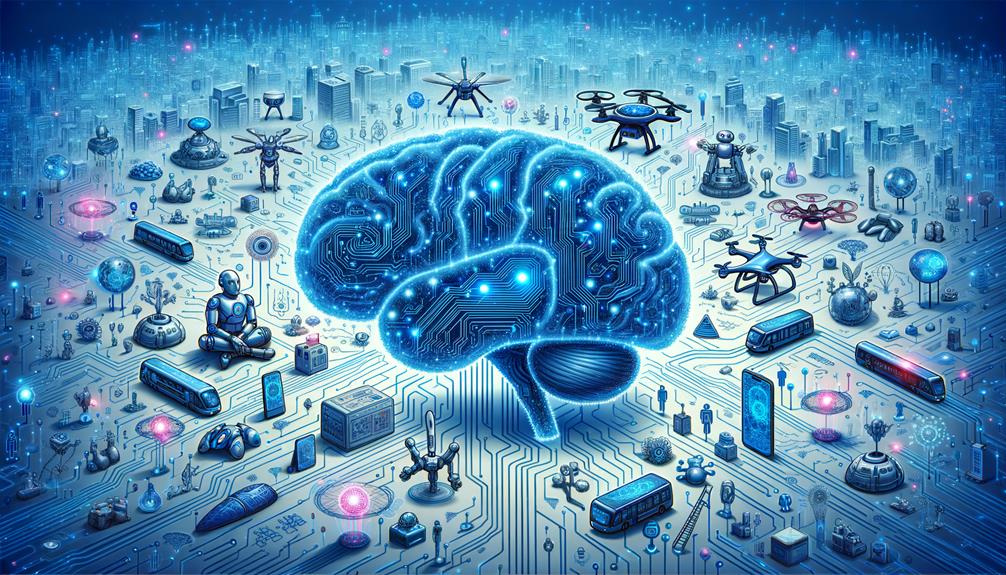

Está a punto de entrar en el fascinante mundo del inteligencia artificial[1]en la que las máquinas aprenden, razonan y resuelven problemas como los humanos. La IA es una rama de la informática que utiliza algoritmos y grandes conjuntos de datos para identificar patrones y hacer predicciones mediante... técnicas de aprendizaje automático. A medida que explore este campo, se encontrará con diferentes tipos de IA, como por ejemplo AI estrecha y IA generalcada una de ellas diseñada para tareas específicas o capacidades cognitivas más generales. Su viaje no ha hecho más que empezar: con la rápida evolución de la IA, aún queda mucho por descubrir sobre su potencial para transformar industrias, sus limitaciones y las funciones que puede desempeñar en la vida cotidiana.
Cuando se oye el término Inteligencia Artificial (IA), es probable que se refiera a una rama de la informática que crea sistemas inteligentes capaces de realizar tareas que normalmente requerirían una inteligencia similar a la humana. Este campo, acuñado por John McCarthy en 1956, se centra en la construcción de sistemas capaces de aprender, razonar y resolver problemas como los humanos.
La IA utiliza algoritmos y grandes cantidades de datos para identificar patrones, hacer predicciones y mejorar su rendimiento mediante técnicas de aprendizaje automático. Encontrará la IA en diversas aplicaciones, entre ellas AI estrecha diseñados para tareas específicas, mientras que IA general sigue siendo un objetivo teórico.
A medida que la IA siga avanzando, veremos cómo transforma sectores como la sanidad, las finanzas y la atención al cliente. Sin embargo, a pesar de su progreso, la IA todavía tiene limitacionesen particular para comprender la inteligencia general y sentido común.
Encontrarás varios tipos de IA, cada uno con capacidades y aplicaciones distintas, que pueden clasificarse en función de sus funcionalidades y objetivos. Vamos a desglosar los principales tipos:
AI estrecha: Diseñado para tareas específicas, como el reconocimiento de voz en asistentes virtuales, destaca en funciones definidas sin capacidades cognitivas más amplias.
IA general: Pretende reproducir capacidades cognitivas similares a las humanas en diversas tareas, pero sigue siendo en gran medida teórica.
IA superinteligente: Una forma hipotética de IA que superaría la inteligencia humana y la capacidad de resolución de problemas, y que podría hacer frente a grandes retos mundiales.
El aprendizaje automático y el aprendizaje profundo son componentes clave de las aplicaciones de IA, que permiten a los sistemas aprender de los datos y mejorar con el tiempo a través del aprendizaje supervisado, no supervisado y de refuerzo.
El procesamiento del lenguaje natural es otro aspecto vital de la IA, que permite a los sistemas entender e interactuar con los humanos de forma eficaz.
La capacidad de la IA para absorber y aplicar conocimientos se basa en aprendizaje automáticoun subconjunto de la inteligencia artificial que permite a los sistemas aprender de los datos y mejorar su rendimiento con el tiempo.
El aprendizaje automático utiliza algoritmos para identificar patrones en grandes conjuntos de datos, haciendo predicciones sin programación explícita.
Existen varios métodos clave, entre ellos aprendizaje supervisadodonde los datos etiquetados enseñan a los sistemas de IA a clasificar la información con precisión.
El aprendizaje no supervisado analiza y agrupa datos no etiquetados, mientras que el aprendizaje por refuerzo recompensa a la IA por las acciones correctas, mejorando la toma de decisiones con el tiempo.
El aprendizaje profundo emplea redes neuronales con múltiples capas para procesar datos complejos, mejorando las capacidades de la IA en tareas como el reconocimiento de voz e imágenes.
Gracias a su capacidad de aprendizaje y adaptación, la IA se está aplicando actualmente en diversos sectores, transformando nuestra forma de vivir y trabajar con sus impresionantes capacidades en áreas como la sanidad, las finanzas y el transporte.
Probablemente ya estés utilizando la IA en tu vida diaria, ya sea a través de asistentes virtuales como Siri o Alexa, o cuando utilizas servicios de banca online y transacciones que dependen de aprendizaje automático para detección del fraude.
He aquí algunos ejemplos Aplicaciones de IA están marcando la diferencia:
En Aplicaciones de IA se integran cada vez más en diversos aspectos de la vida, mitigando los riesgos y abordando las cuestiones éticas asociados a su desarrollo y despliegue se han convertido en prioridades críticas.
Hay que ser consciente de los posibles sesgos que puede perpetuar la IA, que pueden dar lugar a resultados sesgados y reforzar desigualdades sociales. Garantizar la rendición de cuentas, la imparcialidad y la protección de los derechos humanos es esencial, sobre todo a medida que aumentan las capacidades de la IA.
La automatización también plantea problemas desplazamiento laboralmientras que la deriva del modelo pone de manifiesto la necesidad de actualizaciones continuas para mantener la precisión.
Para sortear estos riesgos, hay que priorizar transparenciaPara ello, es necesario realizar pruebas rigurosas y evaluaciones continuas. De este modo, podrá aprovechar el poder de la IA y minimizar sus posibles efectos negativos.
Para acceder a todo el potencial de la inteligencia artificial minimizando sus riesgos, debe priorizar uso responsable de la IA estableciendo y respetando directrices y principios rigurosos. Esto implica crear marcos éticos que garanticen la transparencia, rendición de cuentasy la equidad en los procesos de toma de decisiones en materia de IA.
Tendrá que abordar sesgos potenciales en los datos de entrenamiento que pueden conducir a resultados sesgados. He aquí algunas consideraciones clave:
En sanidad y finanzas a atención al cliente y el transporte, es probable que interactúe con inteligencia artificial en diversos aspectos de su vida cotidiana, a menudo sin darse cuenta.
En sanidad, las aplicaciones de IA están mejorando la precisión de los diagnósticos y creando planes de tratamiento personalizados mediante el aprendizaje automático.
También se está beneficiando de la IA en el servicio de atención al cliente, donde los chatbots proporcionan asistencia 24 horas al día, 7 días a la semana.
Además, vehículos autónomos utilizan la visión por ordenador y el aprendizaje automático para navegar con seguridad.
En finanzas, los sistemas de IA detectan el fraude y reducen los costes operativos.
Las herramientas de IA generativa están transformando incluso campos creativos como el arte y la música.
Estas aplicaciones de IA están revolucionando las industrias y haciendo tu vida más fácil.
A medida que avanza la tecnología de IA, es de esperar que veamos aún más aplicaciones innovadoras en el futuro.
Cada vez verá más inteligencia artificial transformando todos los aspectos de su vida, con avances significativos en razonamiento similar al humano y servicios personalizados en el horizonte.
A medida que evolucionen, las tecnologías de IA desempeñarán un papel fundamental en la automatización de procesos en diversos sectores, lo que podría aumentar la productividad y crear nuevas oportunidades de empleo.
He aquí algunas formas en que la IA afectará a tu vida:
A medida que se desarrolle el futuro de la inteligencia artificial, verá grandes mejoras en su vida cotidiana.
Puedes empezar a aprender IA realizando cursos online, sumergiéndote en proyectos prácticos y dominando lenguajes de programación como Python. Explora las herramientas de IA, los foros de la comunidad y los tutoriales para construir una base sólida y evitar los errores comunes de los principiantes.
Está a punto de sumergirse en la IA, explorando sus fundamentos, incluido el aprendizaje automático, las redes neuronales y la ciencia de datos. Descubrirás aplicaciones como el lenguaje natural, la visión por ordenador y la robótica, al tiempo que consideras las implicaciones éticas y el impacto de la automatización.
¡Estás entre los 70% de profesionales que aprenden IA por su cuenta! Con abundantes recursos de autoaprendizaje, cursos online y proyectos prácticos, puedes dominar los conceptos de IA. Establece objetivos personales, explora herramientas como TensorFlow y participa en los foros de la comunidad para alcanzar el éxito.
Explicará la IA a un profano simplificando conceptos como el aprendizaje automático, las redes neuronales y el procesamiento de datos, y utilizando ejemplos relacionables como el lenguaje natural, la visión por ordenador y las aplicaciones robóticas, al tiempo que analiza las consideraciones éticas y las ventajas de la automatización.